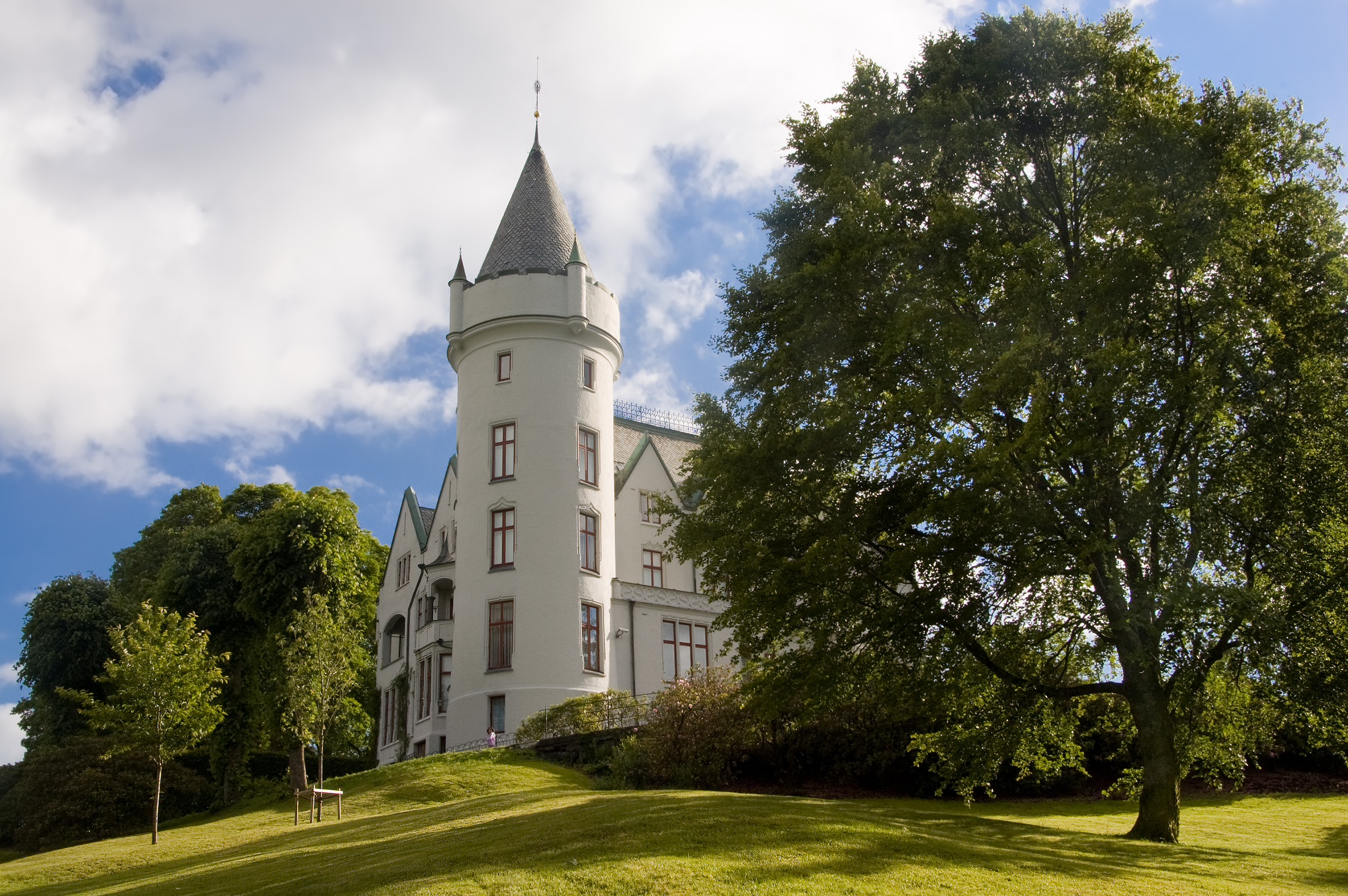- Gamlehaugen
caption=Gamlehaugen seen from the front
name=Gamlehaugen
location_town=Bergen
location_country=Norway
architect=Jens Zetlitz Monrad Kielland
client=Christian Michelsen
engineer=
construction_start_date=1899
completion_date=1900
date_demolished=
cost=
structural_system=
style=Scottish baronial style |Gamlehaugen is a
mansion inBergen ,Norway , and the residence of theNorwegian Royal Family in the city. Gamlehaugen has a history that goes as far back as the Middle Ages, and the list of previous owners includes many of the wealthiest men in Bergen. Today owned by the Norwegian state, the most recent private owner wasChristian Michelsen , a politician and shipping magnate who would later become the firstPrime Minister of Norway after the dissolution of theunion between Sweden and Norway . Michelsen commissioned the construction of the current main building at Gamlehaugen, where he would live for most of the rest of his life.When Michelsen died in 1925, his closest friends and colleagues started a national fund-raising campaign that brought in enough money to allow the Norwegian state to purchase the property. The large English park was opened to the public the same year, and the first floor of the house was opened as a museum two years later. Gamlehaugen has been the Norwegian Royal Family's residence in Bergen since 1927.
History
Gamlehaugen was the site of a farm as early as the
Middle Ages , but it was abandoned as a result of theBlack Death . In 1665, it once again became farmland, as part of the larger Fjøsanger manor. In 1809, Gamlehaugen was separated fromFjøsanger . Marie Krohn, the niece of Danckert Danckertsen Krohn, who had owned Fjøsanger until his death in 1795, built a mansion at Gamlehaugen. A Schack Stenberg purchased Gamlehaugen in 1838. In 1864, Alexander Bull, the son of the violinistOle Bull bought the property, however, he sold it tocopper smith Ole Andreas Gundersen only two years later. The last owner who operated Gamlehaugen as a farm was the merchantAnton Mohr , who bought it in 1878. When he died in 1890, his widow, Alethe Mohr, sold the property to a pair of artisans from Bergen. However, she was allowed to continue using the property and the main building due to a clausule in the sale contract.cite journal | author=Gunnar Hagen Hartvedt| title=Gamlehaugen| journal=Bergen Byleksikon| year=1994| pages=199–200] Cite web|url=http://www.gamlehaugen.no/historie.html|title=Gamlehaugen.no Historie|accessdate=2008-06-25|publisher=Gamlehaugen.no|year=2006|language=Norwegian]In 1898,
Christian Michelsen , a politician and shipping magnate, bought the property. He demolished the existing main building, aSwiss chalet style mansion,Cite web|url=http://www.gamlehaugen.no/parken.html|title=Gamlehaugen.no Parken|accessdate=2008-06-26|publisher=Gamlehaugen.no|year=2006|language=Norwegian] and ordered the construction of a new building in the style of aScottish baronial style castle.Cite web|url=http://www.gamlehaugen.no/english.html|title=Gamlehaugen.no English|accessdate=2008-06-25|publisher=Gamlehaugen.no|year=2006|language=Norwegian] The architect wasJens Zetlitz Monrad Kielland , who would later draw theBergen Railway Station and the brick buildings atBryggen . The construction was finished in 1900, and Michelsen with family moved in the next year. He delegated the task of converting the farmlands surrounding the building into a park to gardener Olav Moen, who designed it as anEnglish park . Barring his years asPrime Minister of Norway from 1905 to 1907, Christian Michelsen lived at Gamlehaugen for the remainder of his life.Following Michelsen's death in 1925, his closest friends and colleagues initiated a national fund-raising campaign which soke to collect the money needed for the state to purchase Gamlehaugen, as well as create afund to pay for the costs of operation and maintenance. While the campaign did not raise the goal of one million NOK, the state did nevertheless buy the property. The fund eventually ran dry, and the state has paid for the upkeep since 1965. Gamlehaugen was renovated between 1989 and 1991 in preparation for Harald V and Queen Sonja's first visit asking andqueen consort .Cite web|url=http://www.statsbygg.no/aapentrom/arkiv/nr3_2001/hovedsak.htm|title=Verneverdig hundreåring|accessdate=2008-06-25|publisher=Statsbygg|author=Hanne Røvig Bauer|language=Norwegian]Park
Prior to Christian Michelsen's acquiration of Gamlehaugen, most of the property was used as farmland. Michelsen gave the task of converting it into a large park to gardener Olav Moen, who would later become a
professor at theNorwegian University of Life Sciences . Moen wanted a park dominated byevergreen plants and trees, however Michelsen's wish for a fruit garden won out in the end. The park was designed as an English garden, adhering to the natural lines and curves of the landscape. The alley which today leads from the main road to the mansion is abaroque element, unfamiliar to the garden as a whole.The park has been open to the public since the state acquired it in 1925. The fruit trees and bushes which were planted when the park was first laid out all died soon after, but the park still contains many of the original trees, several of which are from before Christian Michelsen acquired Gamlehaugen. The park is still a popular
recreation ground , especially due to its location next toNordåsvannet , which allows forbathing and other water activities.Other buildings
The stable is a red building located next to the road. It was originally located near the caretaker's house, which had to be demolished in 1986 when the rock it was built on was blasted away to make room for the widening of the main road. Directly west of the stable is an unused
root cellar . Further west, on the other side of the main building, is agreenhouse , currently used by the janitorial crew. While the greenhouse is relatively small, a larger greenhouse is known to have existed at some point during the time Michelsen was the owner of Gamlehaugen. Finally, aboathouse , built c. 1900, can be found by the waterside in the far north of the property. The property originally contained several additional buildings; the most recent ones to be demolished, apart from the caretaker's house, are a gardener's house, demolished in 1972, and a bath house, demolished in the 1950s, both of which stood by the waterside.Cite web|url=http://www.gamlehaugen.no/bygningene.html|title=Gamlehaugen.no Bygningene|accessdate=2008-06-25|publisher=Gamlehaugen.no|year=2006|language=Norwegian]=See also=
*
List of official residences References
External links
* [http://www.gamlehaugen.no/ Official web site]
Wikimedia Foundation. 2010.

